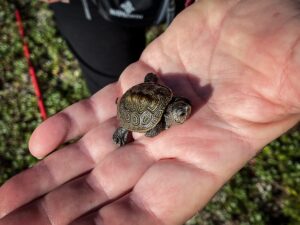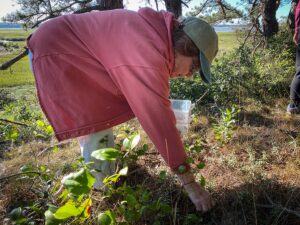WELLFLEET — “Team Turtle!” shouted Norma Ganderson as she pulled her car into the parking lot on the Lieutenant Island causeway.

It was a cool, bright September morning, and a group of volunteers were congregating in the parking lot. Ganderson is part of a five-woman team that meets here early every Wednesday morning in the summer. They are one of many teams working toward one goal: protecting the offspring of threatened diamondback terrapins.
These terrapins are the only turtles in North America to live in brackish water, and Wellfleet holds the northernmost population of the species. For hundreds of years, coastal development and hunting kept terrapin numbers low. But now, after 20 years of work by Mass Audubon’s Wellfleet Bay Sanctuary staff protecting nests, restoring habitat, and educating the public on the plight of these turtles, terrapins appear to be doing better. With only a few days left in the 2023 nesting season, volunteers have found and protected 521 terrapin nests on the Outer Cape, more than in any previous year.
“It seems like the work that’s been done for years is now paying off,” said Nancy Munger, who led the team that morning.
Earlier in the summer, volunteers spent their time scouting for fresh terrapin nests dug in the sand around the edges of salt marshes on the bay side. When they found nests, they protected them, either with a predator excluder — a contraption of cages that keeps out predators like crows, foxes, and raccoons but counts on volunteers coming back later to release the turtles — or with a “self-release” protector that consists of metal chicken wire whose holes are small enough for the baby turtles to squeeze through.
Over the course of the summer, the eggs in these nests slowly developed until they hatched. Most often, the young emerge on their own. If no hatchlings have emerged from a nest within 80 to 90 days, however, the volunteer teams will dig up the nests to see what happened. This was the case today.
The team had two nests they needed to check. As Munger and fellow volunteer Lindi Higgins dug up the nest, they were unsure what they would find. Sometimes a turtle nest can become infested with red ants, or maggots will eat the eggs. Sometimes, the eggs will just inexplicably fail to hatch.

This was not one of those times. After a few minutes of digging, Munger scooped out a hatchling. Then another. Then another. Soon, she was pulling them out two at a time.
In all, the team pulled 11 healthy hatchlings out of the first nest. The baby turtles, each no larger than a matchbook, were set aside to be released in safe upland spots nearby.
Terrapins have very strange life cycles. As adults, they spend their entire lives in the water, only coming onto land to lay eggs or sunbathe. The newborns, though, immediately turn away from the water upon hatching and make their way uphill. There, they bury themselves in leaf litter, where they live for two to three years. For the first winter, they don’t even eat, subsisting instead on the nutrients stored in the yolk sacs that they’ve absorbed during hatching into a cavity in their underbellies.
This period of a terrapin’s life, when they leave the nest for the safety of the uplands, is the most dangerous phase for these reptiles. So, the volunteers at Wellfleet Bay give the turtles “a little leg up on their journey,” said Munger. The team carries the excavated hatchlings up the slope to a suitable area, where each turtle is placed in a safe, damp, shady spot in the leaf litter.
The early days of Mass Audubon’s terrapin project in the 1980s and ’90s were focused on understanding the strange aspects of terrapin natural history. “You can only do conservation if you understand the habitat that the animal is using,” said Barbara Brennessel, professor emerita of biology at Wheaton College and author of the terrapin biology book Diamonds in the Marsh. “Where are they? Where are the females nesting? What are they eating?”
The lives of the hatchlings remain something of a mystery. Being so tiny, they are extremely difficult to study, said Jessica Ciarcia, turtle research coordinator for Mass Audubon. How they choose a suitable upland spot, how much they move around, and how they survive until they reach the water again are all unanswered questions.

Over the course of the morning, the volunteer team excavated two nests of turtles and released a clutch of 11 hatchlings that had been dug up earlier in the week but were not fully developed at the time. This clutch had been kept in a lab back at the Wellfleet Bay Sanctuary while they fully absorbed their yolk sacs. In all, 44 hatchlings were released into the highlands of Lieutenant Island that morning.
As she placed one of the tiny turtles under the shade of a pitch pine, Ganderson bid it farewell: “OK, buddy, you ready to go explore?”
It seems clear that Mass Audubon’s terrapin protection program is aiding the turtle population’s rebound. In addition to this year’s record number of nests (the tally of 521 topped the previous high of 496 found in 2019), Ciarcia said, many of the nests contained smaller clutches of eggs — just 10 or so as opposed to the larger nests with numbers in the high teens. This, she said, is a sign that the mothers are younger terrapins. “There’s a new wave of younger nesters coming up,” she said, “which is a really great sign for the population.”
But the turtles still face threats from development. Human activity destroys their saltmarsh habitat and attracts predators like foxes, raccoons, and skunks. Roads built along the salt marsh create a hazard as the terrapins try to get to the sandy soils they seek for nesting. “Nesting season lines up with that early summer traffic — June and July,” said Ciarcia. “We get many calls every year about hit-by-car terrapins.”
To help solve this problem, the sanctuary staff has begun constructing “turtle gardens,” stretches of empty sandy soil between the marsh and the road. Female terrapins love this habitat, as it provides the perfect place for them to nest without having to cross a road. Brennessel noted that a turtle garden can hold as many as 50 nests. “And those could have been 50 turtle tracks across Route 6,” she said.
As the program grows, Ciarcia hopes the ranks of volunteers will, too. This year, 115 people donated their time and joined a volunteer team to protect the turtles. It’s thanks to people like the five members of Team Turtle that the Outer Cape’s terrapins get a chance to thrive.



